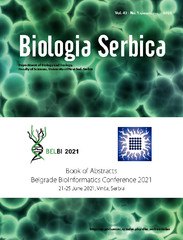Приказ основних података о документу
Large scale mitochondrial DNA analysis of European Honey bee (Apis mellifera) populations from the Balkans, population genetics and phylogeographic perspective
| dc.creator | Erić, Pavle | |
| dc.creator | Patenković, Aleksandra | |
| dc.creator | Erić, Katarina | |
| dc.creator | Tanasić, Vanja | |
| dc.creator | Mihajlović, Milica | |
| dc.creator | Tanasković, Marija | |
| dc.creator | Stanisavljević, Ljubiša | |
| dc.creator | Davidović, Slobodan | |
| dc.date.accessioned | 2021-06-28T13:11:11Z | |
| dc.date.available | 2021-06-28T13:11:11Z | |
| dc.date.issued | 2021 | |
| dc.identifier.issn | 2334-6590 | |
| dc.identifier.uri | https://radar.ibiss.bg.ac.rs/handle/123456789/4253 | |
| dc.description.abstract | Abstract Local populations of Apis mellifera are rapidly changing, with the gene pool of autochthonous breeds being depleted by beekeepers through the import of foreign queens not adapted to the local environment. To study their genetic structure and phylogenetic relationships, we gathered a large dataset from the Balkans and surrounding countries. Our sample consisted of 246 honeybee colonies collected from 47 apiaries and 24 feral colonies divided into four subpopulations from southern Serbia, five from Vojvodina, and two from Belgrade. To evaluate genetic diversity patterns, we sequenced the mitochondrial tRNAleu-cox2 intergenic region. We compared our data to other published data on A.mellifera COI-COII intergenic region variability in the Balkans and neighboring countries. We pulled 1512 sequences from the NCBI GenBank, originating from 15 different populations. The 1782 mitochondrial sequences were grouped into 31 haplotypes, with two newly described haplotypes from our sample. All haplotypes belonged to the eastern Mediterranean C lineage. The most frequent haplotype was C2d, characteristic for A.m.macedonica, followed by C2c and C1a characteristic for A.m.carnica and A.m.ligustica respectively. In our samples 9 haplotypes were observed, with the C2d being the most common and widespread as it was detected in all 11 groups, followed by C2e that was detected in all but one group. C2c and C1a were a little less common than in the total sample but very widespread as they were present in seven groups. When the Macedonia, Ukraine, and Belgrade honeybee populations which consisted of a single haplotype, were excluded, the haplotype diversity ranged from 0.0998 to 0.7477, nucleotide diversity ranged from the lowest value of 0.000114 to 0.003731. The mean number of pairwise differences for populations that had more than one haplotype ranged from 0.060577 to 2. MDS plot constructed on pairwise FST values shows significant geographical stratification, with our subpopulations being grouped together. Vojvodina being placed closer to Romania and Hungary datasets, while southern Serbia is closer to Bulgaria and Montenegro. Interestingly, our samples are not closely grouped with the Serbian dataset from the GenBank which indicates that honeybee populations are changing rapidly. | sr |
| dc.language.iso | en | sr |
| dc.publisher | Novi Sad: Department of Biology and Ecology, Faculty of Sciences, University of Novi Sad | sr |
| dc.relation | info:eu-repo/grantAgreement/ScienceFundRS/Promis/6066205/RS// | sr |
| dc.rights | openAccess | sr |
| dc.rights.uri | https://creativecommons.org/licenses/by-nc-nd/4.0/ | |
| dc.source | Belgrade BioInformatics Conference 2021: Book of Abstracts; 2021 Jun 21-25; Vinča, Serbia | sr |
| dc.subject | Apis mellifera | sr |
| dc.subject | Genetic diversity | sr |
| dc.subject | Subspecies | sr |
| dc.subject | Mitochondrial DNA | sr |
| dc.subject | COI-COII intergenic region | sr |
| dc.title | Large scale mitochondrial DNA analysis of European Honey bee (Apis mellifera) populations from the Balkans, population genetics and phylogeographic perspective | sr |
| dc.type | conferenceObject | sr |
| dc.rights.license | BY-NC-ND | sr |
| dcterms.abstract | Давидовић, Слободан; Ерић, Павле; Патенковић, Aлександра; Ерић, Катарина; Танасић, Вања; Михајловић, Милица; Танасковић, Марија; Станисављевић, Љубиша; | |
| dc.rights.holder | © 2021 the authors | sr |
| dc.citation.issue | 1 | |
| dc.citation.volume | 43 | |
| dc.description.other | Belgrade BioInformatics Conference 2021: Book of Abstracts; 2021 Jun 21-25; Vinča, Serbia. Novi Sad: Department of Biology and Ecology, Faculty of Sciences, University of Novi Sad; 2021. p. 116. (Biologia Serbica; Vol. 43; No. 1). | sr |
| dc.citation.vancouver | Erić P, Patenković A, Erić K, Tanasić V, Mihajlović M, Tanasković M, Stanisavljević L, Davidović S. Large scale mitochondrial DNA analysis of European Honey bee (Apis mellifera) populations from the Balkans, population genetics and phylogeographic perspective [abstract]. In: Belgrade BioInformatics Conference 2021: Book of Abstracts; 2021 Jun 21-25; Vinča, Serbia. Novi Sad: Department of Biology and Ecology, Faculty of Sciences, University of Novi Sad; 2021. p. 116. (Biologia Serbica; Vol. 43; No. 1). | |
| dc.citation.spage | 116 | |
| dc.type.version | publishedVersion | sr |
| dc.identifier.fulltext | https://radar.ibiss.bg.ac.rs/bitstream/id/8535/BELBI-2021-116.pdf | |
| dc.citation.rank | M34 | |
| dc.identifier.rcub | https://hdl.handle.net/21.15107/rcub_ibiss_4253 |

